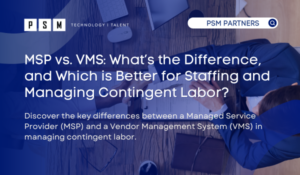Table of Contents
ToggleHiring in the present-day landscape is influenced by various factors, including but not limited to remote and hybrid work arrangements, the integration of automation and artificial intelligence (AI), scarcities in skilled talent, and prevailing economic circumstances. To thrive in this environment, businesses must constantly adapt their recruitment strategies to attract and retain the best talent while maintaining a constant pace with the evolving demands of the workforce. Businesses must enhance their agility and adaptability to abrupt market changes. In response, employers might increasingly turn to flexible workforce options such as contingent workers, whose services can be easily adjusted based on demand, enabling companies to quickly respond to fluctuating needs. According to a McKinsey & Company survey, 36 percent of individuals identified themselves as independent or contingent workers. This statistic underscores the growing trend towards a more dynamic, adaptable workforce. As more workers opt for non-traditional employment arrangements, businesses are increasingly recognizing the value of flexibility and scalability in their staffing strategies. This trend underscores the importance for companies to adapt their hiring and management practices to accommodate this evolving landscape, ensuring they remain competitive and responsive to the changing dynamics of the modern job market.
What is a Contingent Worker?
A contingent worker is classified as an independent contractor or freelancer employed by a company for specific projects or tasks. The defining characteristic of contingent workers is their adaptability, as they seamlessly integrate into a company’s framework for a period of time. Whether a contingent worker works on-site or remotely, their status is determined by the nature of their relationship with the firm that assigns them tasks. This flexibility enables companies to tap into specialized talent pools regardless of geographical constraints, fostering a globalized workforce. However, this autonomy comes at a price, as contingent workers often forgo the security of full-time employee benefits such as health insurance, retirement plans, and paid time off. What truly sets contingent workers apart is their exceptional competence and seasoned expertise. They provide a unique perspective and skill set that can be invaluable to businesses seeking swift and efficient solutions to complex challenges. In this ever-evolving landscape of work arrangements, contingent workers represent a strategic asset for companies navigating the intricate dynamics of the modern labor market.
Types of Contingent Workers in Today's Workforce
Identifying the various types of contingent workers is essential for businesses to adapt to changing workforce trends and for individuals to navigate the evolving job market. Depending on your specific needs, you may find advantages in engaging with one or more of these workers. Each type offers its unique advantages and challenges, making contingent work an integral component of the modern labor market.
- Temporary Workers: Temporary workers, often referred to as temps, play a crucial role in various industries. Staffing agencies hire these temporary employees to fill short-term positions, spanning administrative roles to manufacturing. Typically, temps execute their duties on the client’s premises. Their flexibility shines through as they can be contracted for periods as brief as a few hours or extended to several months, offering businesses a versatile staffing solution. In the dynamic world of contingent labor, temporary workers are a valuable asset, ensuring that companies can swiftly adapt to changing workforce needs.
- Consultants: Consultants, acknowledged as industry experts, provide specialized advice to companies on a project basis. They leverage their expertise to offer valuable insights, enhancing business operations. These professionals operate within intricate domains like intellectual property, corporate strategy, or marketing, catering to businesses in need of expert guidance. Consultants, a vital part of the contingent workforce, excel in advising rather than executing tasks, exhibiting a significant degree of autonomy. Their perspectives and specialized knowledge make them indispensable for businesses seeking to optimize their strategies and operations. When in need of strategic insights, organizations often turn to consultants to navigate complex challenges effectively.
- Independent Contractors: Independent contractors are self-employed professionals hired by companies for specific tasks or projects. They enjoy autonomy in work methods and schedules, but unlike full-time employees, they lack job security and corporate benefits. This category also includes freelancers and gig workers, who work independently without staffing agencies. Independent contractors bear the responsibility for employment taxes. For businesses seeking specialized expertise without long-term commitments, independent contractors offer flexibility and expertise. Understanding these distinctions is essential when navigating the modern workforce, especially in fields like consulting, creative services, or project-based work.
Contingent Worker vs. Employee: Understanding the Key Differences
Contingent workers and full-time employees represent two distinct categories of the modern workforce, each characterized by unique employment arrangements and expectations. Recognizing these distinctions is essential for individuals as they navigate their careers and for companies as they develop strategies for workforce planning and talent management. Let’s delve deeper into the key differences between contingent workers and full-time employees.
- Tax Discrepancies
- Contingent workers fall outside the realm of traditional employment, distinguishing them from full-time employees. Unlike the latter, who receive regular paychecks through the company’s payroll system, contingent workers follow a different compensation structure. When you enlist the services of a contingent worker, typically self-employed, they will bill you directly for the work they provide. Alternatively, if you opt for contingent workers sourced through an agency, it is the agency that will issue you an invoice for the services performed by the individual. Regardless of how integrated these workers are within your operations or the roles they fulfill, your business is not obligated to handle employment tax withholding or remittance. Instead, the responsibility for tax payments and benefit acquisition rests with the individual contingent worker.
- On the other hand, when an individual becomes a full-time employee of a company, the employer is responsible for deducting a portion of the employee’s earnings to cover income tax obligations, along with payroll taxes such as Social Security contributions. This process, often referred to as tax withholding, ensures that employees fulfill their tax responsibilities gradually throughout the year rather than facing a substantial tax bill at the end. By withholding these taxes and remitting them to the appropriate government agencies on behalf of their employees, employers not only comply with legal requirements but also simplify the tax compliance process for their workforce.
- Varieties of Benefits
- Contingent workers find themselves without the privilege of tapping into company benefits or enjoying additional perks like stock options and retirement plans. Independent contractors are responsible for obtaining and arranging these benefits on their own accord. On the other hand, individuals engaged through agencies often benefit from a more streamlined process, as the agency usually manages and addresses their benefit requirements. This distinction underscores the varying degrees of autonomy and support within the contingent workforce, where access to benefits can be a critical factor in the overall employment equation.
- Whereas employees have the potential to become eligible for a range of benefits extended by their employers. These offerings often encompass essential provisions such as group health insurance providing peace of mind. Additionally, employees may have access to retirement savings programs, allowing them to plan for a secure financial future. These employer-sponsored benefits represent a valuable aspect of the overall compensation package, demonstrating the commitment of companies to the welfare and financial stability of their workforce.
- Work Type
- In the realm of job security, full-time employees generally find themselves on more stable ground when compared to their contractor counterparts. The commitment and assurance of consistent employment are intrinsic to the full-time employee status, often shielded from the uncertainties of project-based or temporary work. While contractors may excel in terms of flexibility and variety in their work assignments, they often lack the same level of long-term security and benefits that full-time employees typically enjoy. This difference in job security highlights one of the fundamental distinctions between these two employment arrangements and is a key consideration for individuals navigating the employment landscape.
- Whereas the assurance of continuous employment hinges entirely upon the achievement of specific milestones, such as the successful completion of a particular project, or adhering to the predetermined timeline specified within a contract. In these dynamic and project-oriented work arrangements, job security is tethered to the fulfillment of objectives and the terms set out in the contractual agreement. Once the project is finished or the contract reaches its conclusion, the continuity of employment may be subject to renegotiation or exploration of new opportunities.
- Equipment Needs
- Employers typically provide their full-time employees with the essential tools and equipment required to carry out their job responsibilities effectively. This practice ensures that workers have access to the resources they need to accomplish their tasks efficiently. Whether it’s office supplies, machinery, or specialized software, the provision of these tools not only enhances productivity but also underscores an employer’s commitment to the well-being and success of their workforce. By equipping their full-time employees with the necessary resources, employers contribute to a more conducive and productive work environment.
- Contingent employees often find themselves in a unique position where they are required to invest in their own equipment and may face unreimbursed expenses. Unlike full-time staff who typically receive company-provided tools and resources, contingent workers often have to shoulder the financial burden of acquiring the necessary equipment for their job. This could include anything from laptops and software licenses to specialized tools and uniforms, depending on the nature of their work. Additionally, these individuals might also encounter unreimbursed expenses related to travel, meals, or accommodations, which can add up over time.
Exploring the Key Advantages and Disadvantages of Hiring Contingent Workers
Many businesses opt to hire contingent workers in addition to their permanent staff. Here, you’ll find the key advantages and disadvantages of hiring contingent workers to handle specific tasks.
Advantages:
- Lower Costs: Hiring contingent workers can result in significant cost savings for businesses when compared to the recruitment of part-time or full-time employees. One compelling advantage is that contingent workers typically require minimal onboarding processes and do not rely heavily on HR department resources. Moreover, employers are not obligated to shoulder the costs associated with their training or provide traditional employee benefits such as paid sick leave, vacation time, health insurance, or necessary work equipment.
- Enhanced Expertise: Hiring contingent workers offers a streamlined solution for businesses seeking specialized expertise when internal talent acquisition becomes difficult. In the realm of conventional employee recruitment, there looms the ever-present risk of investing substantial time, often spanning weeks or even months, in the quest for the ideal candidate, only to witness the potential dilution of valuable knowledge and expertise as new hires grapple with inflexible task protocols. Contingent workers, on the other hand, arrive with the coveted proficiency that enterprises demand, while simultaneously wielding the freedom to tackle assignments in accordance with their unique methodologies, thereby ensuring the attainment of exceptional results. This adaptability and agility make contingent workers a strategic choice for companies navigating the dynamic landscape of talent acquisition and resource allocation.
Disadvantages:
- Control: Contingent workers bring a sense of autonomy that many appreciate, and this autonomy often leads to optimal outcomes. However, it can occasionally pose challenges for business owners. Unlike permanent employees, contingent workers cannot always be counted on to adhere strictly to set schedules for work, meetings, or discussions. They thrive on flexibility and independence, which may not always align with rigid project management requirements. This dynamic can be a double-edged sword for business owners. While contingent workers bring fresh perspectives and diverse skills, their independence may not suit those seeking complete control over their workforce.
- Legal Issues: Businesses that rely on contingent workers must be diligent in preventing any misclassification within their workforce. In the event that a federal agency such as the IRS or the Department of Labor determines that an individual who was initially labeled as an independent contractor should, in fact, be considered a full-time employee, the consequences for the employer can be significant. These consequences may encompass potential liabilities, including unpaid payroll taxes, retroactive back pay, omitted benefits, and additional legal obligations, all based on the specific laws and regulations of the jurisdiction. To navigate this complex terrain, business owners who harbor uncertainties about the employment status of a particular worker are strongly encouraged to seek counsel from an employment law attorney, ensuring full compliance with all applicable legal requirements.
Unlocking Insights: Frequently Asked Questions About Contingent Workers
Is a contingent worker an employee?
No, contingent workers are distinguished from traditional employees primarily due to their autonomy within the workplace. Unlike full-time employees, they do not align with the criteria established by common law or comparable employment evaluations. These assessments gauge the extent to which employers exert control over both the nature and the methods of work performed. Contingent workers typically operate with a higher degree of independence, often having more flexibility in how they approach their tasks and projects. This difference in control and work arrangements plays a significant role in distinguishing them from the traditional workforce, making them a valuable resource for companies seeking specialized skills and temporary support.
What is driving the increasing reliance on contingent workers by today’s businesses?
In recent years, advances in technology have transformed the way businesses access specialized services. Due to these innovations, companies can now seamlessly connect with individuals and organizations possessing the expertise they require. With shifting economic dynamics and a changing outlook on employment, the prevalence of contingent workers has surged in today’s job market. These individuals, often sought after for their adaptability and specialized skills, represent a significant portion of the workforce as businesses increasingly recognize the value of flexibility and expertise in achieving their goals. This trend reflects a broader evolution in the way we work and underscores the profound impact of technology on our employment ecosystem.
Is it appropriate to provide salary increases to contingent workers?
Certainly, providing raises to contingent workers is a fair and beneficial practice. While promotions within the traditional corporate hierarchy might not be available to them, it is essential to recognize and reward their contributions. One effective way to do this is by considering increases in their hourly or project-based rates when they consistently demonstrate their value and continually improve their services. By doing so, organizations not only motivate contingent workers to maintain high levels of performance but also foster a sense of appreciation and fairness within the workforce. This approach not only ensures that contingent workers are compensated fairly for their efforts but also contributes to overall productivity and employee satisfaction.
Optimize Your Hiring Process: Discover How PSM Partners Can Help You Find the Right Talent
If your business or institution is confronted with a specialized IT project demanding rapid completion, our IT staffing services are here to assist in the process. We excel in quickly sourcing and delivering qualified candidates tailored to the specific requirements of your IT project. Our approach involves a thorough understanding of your project’s unique needs, followed by the meticulous construction and management of a team comprised of adept consultants. We offer flexible engagement models, including contract and contract-to-hire options, and we go the extra mile to deploy proactive talent retention strategies, ensuring that you can retain your top-performing professionals. With our dedicated professionals by your side, you can be assured of accessing the IT talent necessary to successfully execute any project within a remarkably short timeframe, ultimately driving your business or institution towards its goals with agility and efficiency. To learn more, call PSM at (312) 940-7830 today.
Related Insights
Cybersecurity Jobs to Hire in 2025: Building a Strong Team for the Future
The cybersecurity job market is evolving rapidly, driven by advancements...
Read MoreMSP vs. VMS: What’s the Difference, and Which is Better for Staffing and Managing Contingent Labor?
Contingent workers are reshaping the modern workforce, providing companies with...
Read MoreCybersecurity Engineer vs Analyst: Understanding Key Differences
Implementing robust cybersecurity practices is imperative for companies operating across...
Read More8 Most In-Demand Tech Careers for 2024
Predicting the most sought-after tech jobs for 2024 is challenging...
Read MoreAbout the Author

Taylor Friend
I am a dynamic and results-focused Marketing Coordinator at PSM Partners, recognized for my unwavering motivation, meticulous attention to detail, and unwavering commitment to achieving business objectives. Throughout my time at PSM, I have demonstrated remarkable expertise as the primary liaison for Microsoft and NetDocuments, rapidly establishing myself as a proficient point of contact. Additionally, by harnessing my inherent organizational skills, I have effectively elevated the quality of both our internal and external events.





